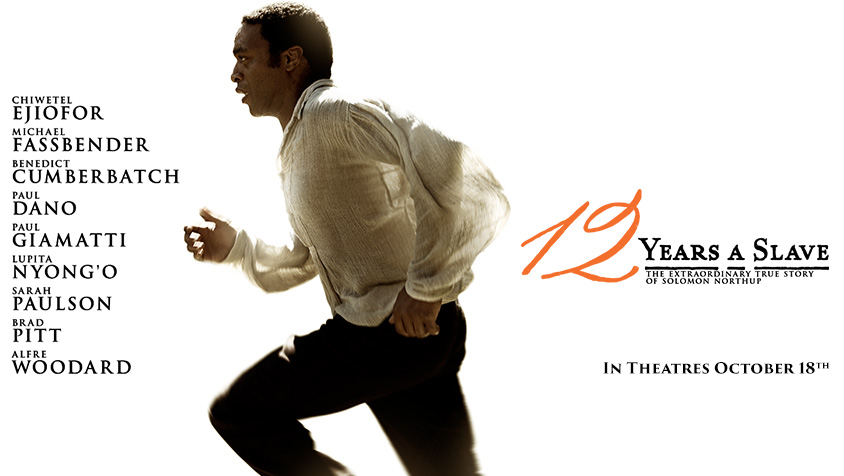12 Years A Slave: It “Gets Into You”

22 Oct 2013
I’m surprised I didn’t leave the theater bawling. From all the reviews I had read of 12 Years A Slave, including people walking out in the middle of the movie, I fully expected to have mascara smeared all over my face after the closing credits started rolling. Instead, I experienced a re-commitment to keeping our stories alive.
12 Years a Slave, the story of Solomon Northup—a free Black man from New York who was sold into slavery in 1841—was as good as you’ve been hearing (lots of Oscar buzz) and as raw and unfiltered a look at slavery as I’ve ever seen. Director, Steve McQueen was masterful in his weaving of a mosaic of complex themes that make up the intricate fabric of a story that will seep into your soul and stay there for awhile. Chiwetel Ejiofor gave a riveting performance as he took on the spirit of Solomon Northup and made you forget it was a re-enactment of a story that took place almost two centuries ago.
Before I went into the screening, hosted by Fox Searchlight and the Motion Picture Association of America, I spoke with one lady who had gone with her 26-year-old daughter to see the movie the week before. After watching the movie, her daughter called her the next day and told her she hadn’t been able to sleep that night. The movie had “gotten into her.” She couldn’t stop thinking about the characters. Neither can I.
I kept thinking, as I watched Patsy (a fellow slave on the plantation with Northup—brilliantly played by Kenyan actress, Lupita Nyong'o) being whipped within an inch of her life, “That could have been me.” As a Black woman, I don’t know how you can’t have that thought watching this epic movie. And as an African, it gave me a renewed appreciation for what my African American brothers and sisters suffered for me to have the opportunities I do today.
Being a woman of faith, there was no way I could miss the underlying theme of suffering, purpose and redemption in this movie. In fact, when you witness atrocities like this, you’re almost forced to try to find what good can come out of any such thing. Solomon Northup, having been born free in New York and established a comfortable life with his wife and three children, had never known, or had to experience the blight of slavery. His ungodly introduction into the “peculiar institution” was met with a spirit of defiance that refused to accept this reality which was imposed upon him for twelve years.
Twelve years of watching his fellow enslaved Blacks get lynched, whipped at the whim of insane masters, refused proper food and hygiene, suffering at the hands of people that looked at them as nothing more than property—chattel. His innocence (or maybe ignorance) was literally stolen. But despite all this, Northup somehow managed to keep his hope and faith and GOODNESS with him. It was what kept him alive.
When he finally returned to his wife and (now grown) children with the help of a white carpenter, he wrote his now-famous book and became an outspoken crusader against the institution of slavery. In fact, his book, which was published in 1853 just five months after his release from captivity, along with Harriet Beecher Stowe’s Uncle Tom’s Cabin, are said to have “helped lay the groundwork for the Civil War.” And here we begin to understand—to a large degree—the purpose of Solomon’s suffering for a much greater cause.
Condoleeza Rice once said that “Slavery is America’s birth defect.” In 1776, when America was born from the American Revolution, slavery was already a well-established institution. In 2013, much has changed and yet that which is a remnant of slavery is only beginning to really be acknowledged. You can’t fix what you don’t admit. And the reality is that the implicit and explicit racism we still deal with in the U.S. today is a direct product of slavery. What is the solution to a problem that has so many complexities and is embedded in the DNA of a nation? There is no one answer.
However, watching this movie gave me additional perspective on my responsibility to contributing to the solution. What form that will take for each of us, I can’t say. You can start with going to see this movie and taking a friend with you. Go. See. The Movie. Then write about it. Tweet about it. Blog about it. Start a dialogue about it. Tell others to see it. But by all means, don’t let the story end here.
If you’ve seen 12 Years A Slave, what impact did it have on you? Leave your comments below and let me know what you think.
Recommended Posts

20 Unforgettable Lessons I Learned from the Steve Harvey Act Like A Success Conference (Part II)
09 May 2017 - Personal Growth, Purpose





[…] Washington, DC and sold into slavery in Louisiana for twelve years. (Read my review about the movie here.) Besides being a prolific, big-screen actress, Nyong’o also acted in the hit Kenyan […]
Beautifully written sister. I can't wait to see the movie with my 17 year old daughter.
Thank you Dawn. I think this is one of the most important movies I have ever seen on the issue of slavery and Black history in general.